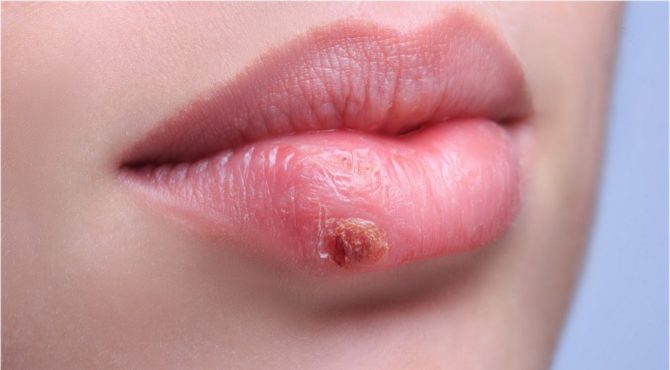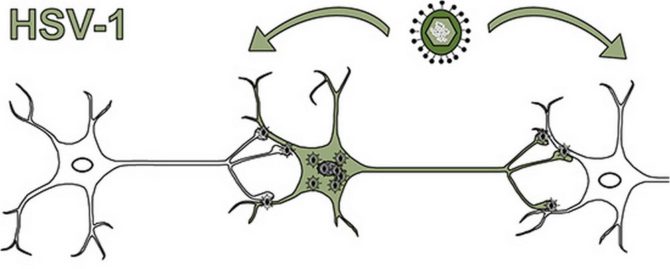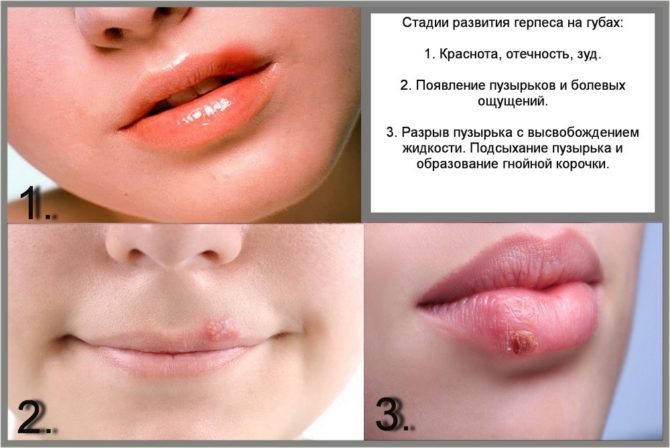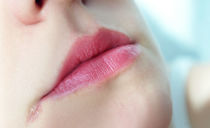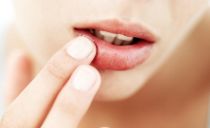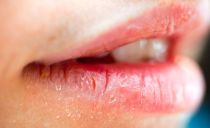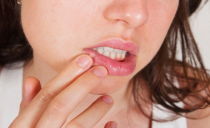Herpetic rashes on the lips: the nature of the disease, symptoms, treatment
Herpes on the lips is chronic infectious viral disease. Pathogenic particles enter the body through the skin and integrate into the replication apparatus of nerve cells. Periodically, when for some internal reason the immune system weakens, the virus migrates back to the cells of the upper layers of the skin and infects them, which leads to the appearance of painful vesicles.
Content
Herpes virus: basic information
In nature, there are 8 varieties of herpes viruses to which the human body is susceptible. And each is characterized by different localization of rashes:
- Herpes simplex virus type 1. It affects the skin in the upper torso. May occur on lips, cheeks, eyebrows, chin, nose, in the ears or eyes. According to statistics, about 70% of the world's population is infected with this type of herpes virus.
- Herpes simplex virus type 2. Sexually transmitted and localized in the lower body: on the genitals. The disease increases the risk of developing STIs. Infection during pregnancy is fraught with miscarriage or infection of the fetus.
- Herpes virus type 3 or Herpes zoster. Causes chickenpox, which affects almost all children. After recovery, a person remains a virus carrier for the rest of his life. Relapses, if any, provoke the development of shingles. It is localized in the upper body. It affects the skin in the chest, neck, lower back.
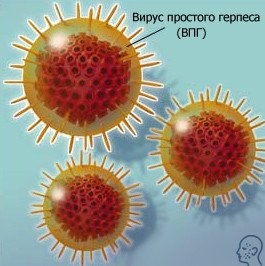 Herpes virus type 4 or Epstein-Barr. It is the causative agent of mononucleosis - a disease characterized by damage to the pharynx, liver, spleen and changes in the morphology of blood cells. Infection is acute: there is a significant increase in temperature, pain in the lymph nodes.
Herpes virus type 4 or Epstein-Barr. It is the causative agent of mononucleosis - a disease characterized by damage to the pharynx, liver, spleen and changes in the morphology of blood cells. Infection is acute: there is a significant increase in temperature, pain in the lymph nodes.- Herpes virus type 5. It provokes the development of cytomegalovirus infection. Symptoms of the disease are rare, as it is characterized by a sluggish virus carrier. Both primary infection and relapses are dangerous for the fetus, as they lead to the development of congenital malformations.
- Herpes virus type 6. It provokes an ailment like roseola for children. Its other names are sixth disease, three-day fever, pseudo-rubella, or sudden exanthema. Most often, roseolovirus manifests itself in children under two years of age and does not require specific treatment.
- Herpes virus type 7. According to many scientists, it is the cause of the development of chronic fatigue syndrome. The mechanism of its occurrence is logical: the virus accumulates in the centers of the ANS - the autonomic nervous system, where it provokes inhibition of the zone responsible for inhibitory processes.
- Herpes virus type 8. Causes a number of dangerous pathologies, including Kaposi’s Sarcoma, serous cavity lymphoma, Castelman’s disease. But it is activated only with a prolonged and persistent decrease in immunity. For example, with HIV.
Persons who have already developed antibodies to virus-1 in the body do not have antibodies to virus-2. And the localization of rashes can change: herpes of the second type can affect the lips, and the first - the genitals. Therefore, doctors recommend avoiding oral-genital contacts.
Conclusion: herpes on the lips manifests itself when the first type of virus is activated. Less often - the second. Other names for these pathogenic particles can be found in the medical literature: Herpes simplex virus, HSV-1 (2), Human herpesvirus, or HSV-1 (2).
Ways and stages of infection
HSV-1 can be infected both from a sick person and from the carrier. Usually, the first contact with the virus occurs even in infancy, but herpes appears on the lips later: when immunity decreases.
Ways of infection:
- Contact: through a kiss, handkerchief, lipstick.
- Airborne: when near a person who has a relapse.
- Sexual: with oral-genital contact.
- Intrauterine: infection of the fetus from the mother.
- Transfusion: with a blood or plasma transfusion.
When a viral particle enters the skin, it “searches” for the easiest ways to enter the body. These are the soft mucous membranes of the lips. Therefore, herpes also affects them more often than areas near the lips, nose, ears, cheeks and eyes, which are not as favorable for its development.
Immediately after infection, the virus enters the axons of nerve cells, migrates along the nerves to their replication apparatus and embeds its genetic material (DNA) into the chromosomes of the host cells. As a result, infected cells begin to produce new viral particles, and a person becomes a lifelong carrier of herpes on the lips.
The body is able to suppress the primary infection. When this happens, the patient will develop immunity to the virus. New pathogens produced by infected host cells will be immediately destroyed by antibodies - equilibrium will arise.
But acquired immunity is not sterile. In the case of a decrease in the protective functions of the body, for example, against the background of a lack of vitamins, individual viral particles at the dendrites (processes) of the neurons will reach the surface of the skin and affect its cells, as a result of which the herpes on the lips will go into the active phase.
Key findings:
- After penetration of the chromosomes of cells, it is impossible to destroy HSV-1, since it is stored in them in the form of genes. For this, all neurons would have to be replaced, and modern medicine is not yet capable of it.
- External manifestations of HSV-1 begin to bother a person only after a weakening of immunity. When it is healthy, the virus is in sleep mode.
Interesting fact! 5% of people are immune to Herpes simplex virus 1. The causes of this phenomenon are still unknown.
Leading to relapse
Primary infection with HSV-1 is often asymptomatic. And the repeated activation of herpes on the lips is possible only at times when a person's immunity is reduced. The latter can occur under the influence of such factors:
- Hypothermia.
- Food or chemical poisoning.
- Vitamin deficiency.
- Living in adverse conditions.
- Frequent colds, infectious diseases.
- Pathology of the skin, mucous membranes.
- AIDS and the development of malignant tumors.
- Severe and / or prolonged stress.
- Diabetes mellitus, adrenal gland dysfunction or other endocrine pathologies.
In some carriers of HSV-1, the infection never manifests itself. Usually they don’t even know that they are infected.
Signs and stages of the disease
Symptoms of herpes on the lips appear no earlier than 7-30 days after the penetration of pathogens into the human body. The process of development of the disease can be divided into 4 characteristic stages:
- First, the patient begins to feel itching, and the future lesion area acquires a red tint. These are the first signs of the development of herpes on the lips. If, after their detection, immediately proceed to ointment therapy, then rashes can be avoided.
- Then the itching intensifies, and a small, painful vesicle, filled with a clear liquid, appears on the lip, which gradually increases. As the formation grows, the exudate filling it becomes cloudy.
- After 2–4 days, the bubble bursts, and a liquid flows out of it, which contains a huge amount of viral agents. At this stage of herpes on the lips, the patient is most dangerous to others, since pathogenic particles easily survive in the external environment and spread by airborne droplets.
- Over the next 7 days, herpes heals: ulcers form on the site of the bursting vesicles, then they dry out, the crusts fall off, and the skin begins to recover. If the treatment of herpes on the lips was started late, then at this stage a new relapse may occur..
With the development of an ailment, some people display generalized symptoms: general malaise, headache, fever. Most often this happens with primary infection.
Which doctor should I contact
Treatment of herpes on the lips is the task of a dermatologist or infectious disease specialist. If the bubbles characteristic of the disease appear on the mucous membrane of the oral cavity, you can visit the dentist. In the eye area - an ophthalmologist. On the genitals - a gynecologist or urologist.
To find out and eliminate the cause that led to a decrease in immunity and activation of viral agents, you should consult a therapist. And for the appointment of drugs that contribute to the restoration of the body's defenses, to the immunologist.
Diagnosis of the disease
Herpes leads to the formation of very specific rashes, so a cursory examination is usually sufficient to make the correct diagnosis. If necessary, doctors can prescribe laboratory tests such as:
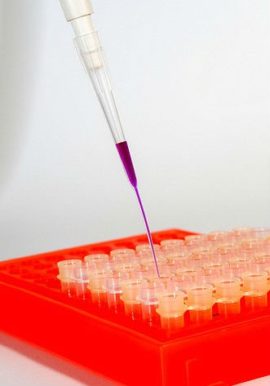 ELISA or enzyme immunoassay - a study of blood from a vein. It consists in the detection of antibodies to Human herpesvirus in the patient's blood. If the body contains immune particles, then there is a pathogen. Moreover, the concentration of antibodies in the sample can be determined, which led to the appearance of a rash: primary infection or relapse of chronic herpes. Because it increases over time.
ELISA or enzyme immunoassay - a study of blood from a vein. It consists in the detection of antibodies to Human herpesvirus in the patient's blood. If the body contains immune particles, then there is a pathogen. Moreover, the concentration of antibodies in the sample can be determined, which led to the appearance of a rash: primary infection or relapse of chronic herpes. Because it increases over time.- PCR or polymerase chain reaction - a study of the blood or contents of the vesicles. It consists in detecting the DNA of the virus in the taken material. That is, the procedure is aimed at finding a specific pathogen.
- Immunofluorescence - a study of the contents of the vesicles. It consists in the detection of virus antigens. If the pathogen is present in the patient’s body, then after the chemical reactions, the material taken will begin to glow.
- General blood and urine tests. They are always prescribed, no matter what disease is suspected. With herpes on the lips, the indicators are usually normal.
How to cure herpes
Most often, the disease is treated at home. However, with the development of complications and severe manifestation, inpatient therapy is prescribed.
The list of medications depends on the stage of the disease. During the exacerbation, antiherpetic agents, immunomodulators that restore cellular immunity, as well as interferon inducers are indicated. And during the remission of herpes on the lips, treatment should be directed to reducing intoxication syndrome and strengthening the body's protective functions with the help of adaptogens, antioxidants and prostaglandin inhibitors.
Antiviral drugs that could remove DNA fragments of pathogenic particles from the body do not yet exist. All that modern pharmacology offers a person is means aimed at suppressing the activity of HSV.
The following drugs can be used to treat herpes on the lips:
| Name of medication | Release form | Operating principle | Terms of use |
|---|---|---|---|
|
Ointment or cream | The active substance of the agents interacts with the DNA molecules of the virus and breaks them, which prevents the pathogen from multiplying. | Apply to the affected area of the skin 5 times a day. The course of treatment is 7-10 days. |
|
100 mg tablets | They block the penetration of viral particles into the cell and inhibit the exit from it, which leads to a decrease in the number of pathogens in the body. | Adults take 1 tablet 2 times a day. |
|
250 mg tablets | The active substance of the drugs penetrates the infected cell and inhibits the replication of viral DNA, which helps to cure cold sores on the lips. | Take 1 tablet 3 times a day. |
|
Gel | Activates the recognition by antibodies of infected skin cells and helps suppress the replication of viral particles. | It is applied to the “cold” on the lips several times a day. The duration of treatment is three days. |
|
Gel | Interacts with receptors of affected skin cells and helps suppress DNA replication of viral particles. | It is applied to the lesions every 12 hours. |
Attention! When treating cold sores on the lips with these drugs, study the instructions attached to them: there are contraindications. And also do not forget to wash your hands before and after applying ointments to avoid infection of healthy skin areas: eyes, cheeks, ears.
Folk remedies
Herpes can be treated on the lips with the help of alternative therapy. It will not replace medication, but will accelerate the healing of damaged skin.
Such means quickly and effectively cope with an ailment:
- Peppermint. Connect 1 tbsp. l plants and 200 ml of water, put the mixture in a water bath and boil for 15 minutes. Lubricate herpes with a decoction on the lips several times a day.
- Garlic. Grate 2 cloves on a fine grater and wrap in gauze. Apply a compress to the inflamed area for 5-10 minutes. It is not worth holding the product longer, as you can get a burn.
 Fir oil. Lubricate cold sores on the lips every 2 hours.
Fir oil. Lubricate cold sores on the lips every 2 hours.- Propolis tincture. Apply liquid to a cotton swab or swab and lubricate the sore that remains in place of the bubble. After cauterization, an emollient cream is recommended.
- Hydrogen peroxide. Dip a cotton swab into the preparation and treat herpes on the lip. Repeat after 12 hours.
- Soda. Boil 200 ml of water, pour in it 1 tbsp. l substance and stir until dissolved. Soak a cotton swab in the mixture and apply to the herpetic vial. Perform the procedure every 3 hours.
Herpes Prevention
Relapse rate can be reduced. The first thing to do is adjust the diet. Preference is given to products that are rich in lysine - an amino acid that inhibits the reproduction of the virus. It is found in milk, fruits, vegetables and poultry. It will be necessary to refuse chocolate and raisins, since these products are rich in arginine - an amino acid that is necessary for viral particles to reproduce.
Since herpes on the lips manifests itself only against a background of weakened immunity, it is necessary to constantly strengthen it. To do this, you need to temper, be in the fresh air, go in for fast walking, cycling or other active type of pastime. To use vitamin complexes. And, most importantly, consult a physician at least once a year.
To prevent infection with the herpes virus, it is necessary to limit contacts with people who have obvious signs of a recurring or primary infection. Especially if herpes on the lips has not yet covered with a dried crust.

